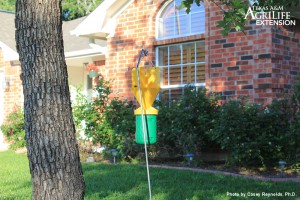Casey Reynolds, PhD, Mike Merchant, PhD and Diane Silcox Reynolds, PhD
White Grubs: Phyllophaga crinita Burmeister, Phyllophaga congrua LeConte, Cyclocephala lurida Bland, and others
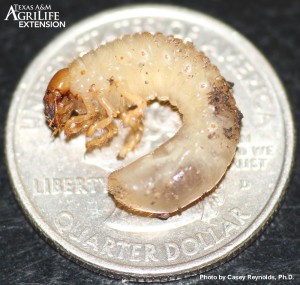
White grubs (Figure 1) are the larval stage of scarab beetles, AKA- May/June beetles or Chafers. There are over 100 species of May/June beetles in Texas, but only a few species cause damage to turfgrass. Those species include Phyllophaga crinita and Phyllophaga congrua (May/June beetles) (Figure 2), as well as Cyclocephala lurida (southern masked chafer) (Figure 3). White grubs feed on the roots and other below ground portions of warm-season turfgrasses, such as bermudagrass, zoysiagrass, buffalograss, and St. Augustinegrass, as well as cool-season turfgrasses such as fescues, bluegrasses, and ryegrasses. Visible damage includes irregularly shaped patches of dead turfgrass that may resemble symptoms of drought-stress. In severe cases, damaged turfgrass can often be rolled up like a carpet (Figure 4). Secondary damage may also occur in the form of damage from skunks, raccoons, and armadillos digging through the turfgrass to seek and feed on grubs. Such damage may be particularly severe on golf courses, home lawns, or athletic facilities adjacent to wooded areas. As with the successful management of many species of insect pests, a critical component of effective white grub management is prevention.
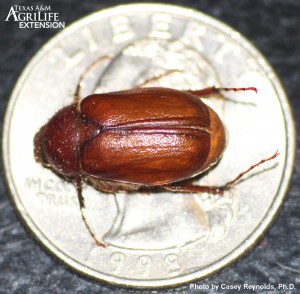
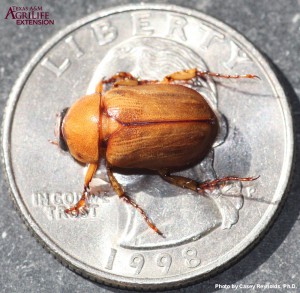
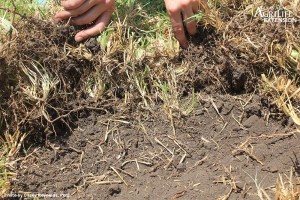
White Grub Life Cycle

White grubs generally cease feeding in the fall and remain mostly dormant throughout the winter and into the spring months. In the spring they move closer to the soil surface and begin feeding for a brief period of time. However, damage at this time is not significant, and control is not recommended. In April and May the larvae pupate in preparation for becoming an adult.
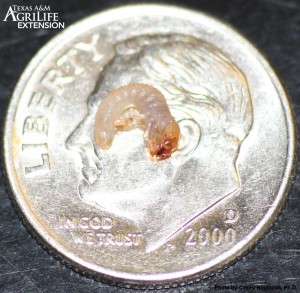
It’s important to note that between March and June several other species of scarab beetles may also emerge in large numbers and be attracted to windows and lights. Although related to the June beetle, these early-emerging beetles are not damaging to turfgrass (though a few may feed on and temporarily defoliate trees and other plants). No treatments should be needed at this time.
In about two weeks the small first instar grubs (Figure 6) emerge and begin to feed on turfgrass roots. The ideal treatment time for white grubs is around the time grubs hatch or in the first few weeks of development. Later stages can be more difficult to control and significant turf damage may have already occurred. Generally speaking, June is the ideal time to treat for white grubs in south Texas while early July is more appropriate in north Texas. If left uncontrolled, white grubs will continue to feed throughout the summer months and kill or thin turfgrass stands.
Control of White Grubs
Not all lawns, athletic fields, or golf courses require regular treatment for white grubs, yet some sites that are prone to white grub damage may need to be treated on an annual basis. Although it is possible to sample for white grubs to determine whether treatment is needed (5 to 10 grubs per square foot is considered the threshold above which damage occurs), few people take the time or want to dig up areas to sample for these insects. Consequently, high value turf, or turf that has a history of damage from white grubs are the types of sites where annual white grub treatment may be justified.

Most of today’s white grub insecticides have relatively long persistence in the soil; however applications made too early may break down before white grubs are present. Therefore it is usually best to wait until after June beetle mating flights end before putting out an insecticide. Effective preventative treatments include products containing the insecticide active ingredients chlorantraniliprole, clothianidin, cyantraniliprole, imidacloprid, or thiamethoxam. There are also combination products available that contain bifenthrin mixed with either clothianidin or imidacloprid that are labeled for preventative treatment. Although these treatments can also provide some control after damage appears, they are most effective if applied early.
To confirm that white grubs are the reason for yellowing or dying patches of turfgrass, dig up some small sections on the edge of dying grass. If grass readily pulls up, with few roots, and grubs are apparent in the soil (5 to 10 grubs or more per square foot), then treatment may be justified. Late season treatments, in addition to the ones listed above, may include carbaryl, chlorpyrifos, dinotefuron, lambda-cyhalothrin, or trichlorfon; however, unlike preventative treatments these products have relatively short residual activity in the soil after application.
Organic Options
Insect-killing nematodes have shown effectiveness against white grubs in numerous trials, but they tend to be more difficult and expensive to use. The ground should be kept moist prior to application of nematodes, and at least one half inch of water applied immediately after nematodes are sprayed. It is prudent to buy nematodes directly from online suppliers with a good reputation for quality control and prompt shipment. When buying in a store it can be difficult to know whether they have been shipped and stored properly, and whether they are still fresh and viable.
Watering Before and After Treatment
For both chemical and biological treatments, irrigation is essential. Pre-treatment irrigation encourages white grubs to come closer to the surface, and helps prepare the soil for better insecticide (or nematode) penetration. For dry soils, apply ¼ to ½ inch of irrigation one day prior to application.
Both insecticides and nematodes also require post application irrigation. Insecticides require water to move through the thatch layer and down into the root zone where grubs feed. One-half to one inch of irrigation should be applied immediately (before the product has dried) following application of a nematode treatment or a liquid insecticide treatment. Granular insecticides do not have to be watered in immediately; but they will not provide control until they are watered in. For specific product recommendations on white grub control, please consult the Texas Turfgrass Pest Control Recommendations guide. As always, be sure to read and follow label directions for control recommendations and precautionary statements.

